


|
| ||
|
|
|
|
|
|
SILVER EDITION

|


|
SILVER EDITION |
|
Publication History
Cover Overview |
Reviews and Previews
Chapter Overview |
Word Cloud
[NEW]
First Chapter Preview [NEW] |
Cover Gallery (year)
Cover Gallery (edition) |
 Cover Overview
Cover Overview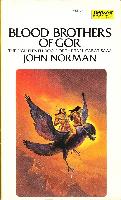
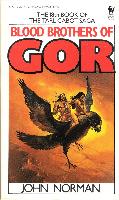
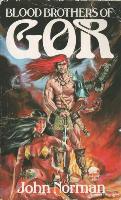
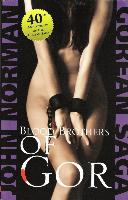
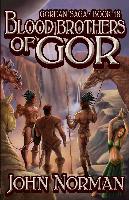
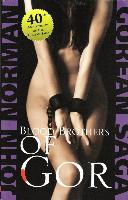
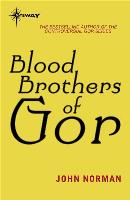
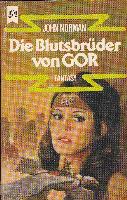
 Reviews and Previews
Reviews and Previews Chapter Overview
Chapter OverviewHere is an overview of the 56 chapters in Blood Brothers of Gor:
|
1. The Pte
2. The Procession of the Isanna 3. The Pole 4. The Kaiila Will Go Forth For the Hunt 5. Cuwignaka and I Will Go to the Draw 6. What Occurred in the Draw 7. Bloketu and Iwoso Come Visiting 8. I Take my Leave from Grunt's Lodge 9. This Occurred in the Lodge of Cuwignaka 10. An Improved Slave is Returned to her Master 11. It Is in the Time of Festivals 12. I Utilize the Entitlements of the Beaded Quirt 13. I Learn of the Presence of Waniyanpi 14. Waniyanpi 15. Hci's Trick 16. Oiputake 17. An Assessment of the Information of Oiputake 18. I Continue to Seek an Assessment of Oiputake 19. I Speak With Cuwignaka 20. Kinyanpi 21. Yellow Knives 22. Cuwignaka Requests Instruction 23. Cuwignaka and the Slave 24. We Obtain Kaiila 25. We Speak With a Kaiila Warrior 26. Once More to Tread Disputed Bloody Dust 27. Fighting 28. Fighting Continues |
29. How It Came About That Grunt Survived
30. Sardak 31. In Grunt's Lodge 32. What Cuwignaka Decided To Do 33. Mira 34. Squash and Strawberry 35. In the Vision Place 36. The Pit 37. What Occurred In the Pit 38. A Slave Is Punished 39. The Feather 40. In the Compound of the Waniyanpi 41. Hci Will Come With Us 42. The Sky Seems Clear Behind Me 43. What Occurred When We Visited a Yellow-Knife Camp 44. Yellow Knifes Come to Council Rock 45. What Occurred at Night at Council Rock 46. The Second Day of War 47. The Third Day of War 48. Two Women 49. Judgment 50. What Occurred at the Summit of the Trail 51. The Fleer Bring a Visitor to Camp 52. A Boon 53. The Red-Haired Slave Girl 54. I Return to My Lodge 55. The Comminglings of Blood 56. I Take My Leave From the Camp |
 Word Cloud
Word CloudThe image below shows the most often used words and terms within Blood Brothers of Gor. The larger the size, the more often the word or term occurs in the text.
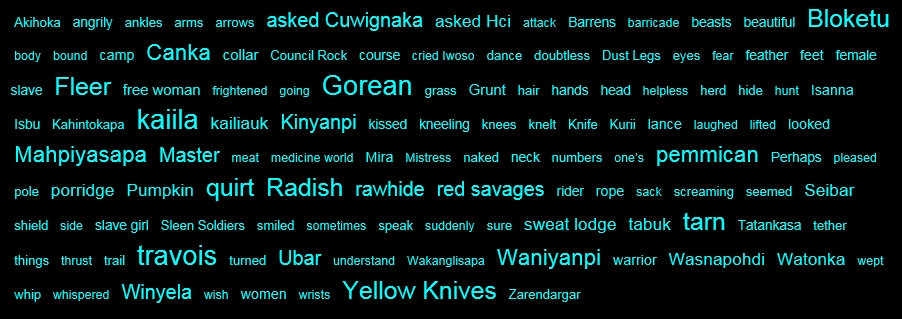
 First Chapter Preview
First Chapter Preview
1
The Pte
"There it is," said Grunt, pointing ahead and to our right. "Do you see it?"
"Yes," I said. "Too, I feel it." I could feel the tremor in the earth, even through the paws and legs of the lofty, silken kaiila.
"I have seen it only once before," he said.
I rose in the stirrups. The vibration, clearly, was registered in the narrow, flat-based rings. Earlier, dismounted, we had placed the palms of our hands to the earth. It was then that we had first felt it, earlier this morning, from as faraway as perhaps twenty pasangs.
"They are coming," had said Cuwignaka, happily.
"I am puzzled," said Grunt. "It is early, is it not?"
I sat back on the saddle.
"Yes," said Cuwignaka, astride his kaiila, to my left.
The current moon was Takiyuhawi, the moon in which the tabuk rut. It is sometimes known also as Canpasapawi, or the moon when the chokecherries are ripe.
"I do not understand," said Grunt. "It is not due until Kantasawi." This was the moon in which the plums become red. It is generally the hottest time of the year in the Barrens. It occurs in the latter portion of the summer.
"Why is it early?" asked Grunt.
"I do not know," said Cuwignaka.
Our kaiila shifted beneath us, on the grassy rise. The grass here came to the knees of the kaiila. It would have come to the thighs of a girl.
"Perhaps there is some mistake," I suggested. "Perhaps it is not what you think."
"There is no mistaking it," said Grunt.
"No," said Cuwignaka, happily.
"Could it not be another?" I asked.
"No," said Cuwignaka.
"These things are like the summer and the winter," said Grunt, "like the phases of the moons, like day and night."
"Why then is it early?" I asked.
"Has it been early before?" asked Grunt of Cuwignaka.
"Not in my lifetime," said Cuwignaka. "In the old stories it has sometimes been late, but never, as far as I know, has it been early."
"Think," I said. "Can you recall nothing of such a sort?"
Cuwignaka shrugged. "I can think of nothing of that sort," he said.
"Can there be no mistake?" I asked Grunt.
"No," said Grunt. "It is here."
"It looks like it is raining there," I said.
"That is dust, in the wind," said Cuwignaka. "It is raised by the hoofs."
"It is here," said Grunt. "There is no doubt about it."
I looked into the distance. It was like a Vosk of horn and hide.
"How long is it?" I asked. I could not even see the end of it.
"It is probably about fifteen pasangs in length," said Grunt. "It is some four or five pasangs in width."
"It can take the better part of a day to ride around it," said Cuwignaka.
"How many beasts are numbered in such a group?" I asked.
"Who has counted the stars, who has numbered the blades of grass," said Cuwignaka.
"It is estimated," said Grunt, "that there are between some two and three million beasts there."
"Surely it is the largest such group in the Barrens," I said.
"No," said Grunt, "there are larger. Boswell claims to have seen one such group which took five days to swim a river."
"How long would it take a group like this to swim a river?" I asked.
"Two to three days," said Grunt.
"I see," I said. The Boswell he had referred to, incidentally, was the same fellow for whom the Boswell Pass through the Thentis Mountains had been named. He was an early explorer in the Barrens. Others were such men as Diaz, Hogarthe and Bento.
"It is an awesome and splendid sight," I said. "Let us ride closer."
"But let us be careful," said Cuwignaka. Then, with a cry of pleasure, kicking his heels back into the flanks of his kaiila, he urged his beast down the slope.
Grunt and I looked at one another, and grinned. "He is still a boy," said Grunt.
We then followed Cuwignaka. It was toward noon when we reined up beside him on another rise. The animals were now some three to four pasangs away, below us.
"It is the Pte!" called out Cuwignaka happily to us, turning to look at us.
"Yes," said Grunt.
We could now smell the animals clearly. My mount, a lofty black kaiila, silken and swift, shifted nervously beneath me. Its nostrils were flared. Its storm lids were drawn, giving its large round eyes a distinctive yellowish cast. I did not think that it, a kaiila purchased some months ago in the town of Kailiauk, near the perimeter, had ever smelled such beasts before, and certainly not in such numbers. Too, I supposed that there were many among such beasts, perhaps most, in fact, who had never smelled a man, or a kaiila, before. Grit and dust settled about us. I blinked my eyes against it. It was very impressive to be so close to such beasts. I scarcely dared to conjecture what it might be like to be even closer, say, within a few hundred yards of them. Individual kills on such animals, incidentally, are commonly made from distances where one can almost reach out and touch the beast. One must be that close for the lance thrust to be made or for the arrow, from the small bow, to strike with sufficient depth, to the feathers, either into the intestinal cavity behind the last rib, resulting in large-scale internal hemorrhaging, or behind the left shoulder blade, into the heart.
"Is there always this much dust?" I asked. I raised my voice somewhat, against the sounds of the beasts, their bellowing and the thud of the hoofs.
"No," said Cuwignaka, raising his voice. "It is moving now, not drifting and grazing."
"Sometimes, for no clear reason," said Grunt, "it will move, and more or less swiftly. Then, at other times, for similarly no apparent reason, it will halt and graze, or move slowly, gently grazing along the way."
"It is early," I said.
"Yes," said Grunt. "That is interesting. It must have been moving more than is usual."
"I will inspect the animals," said Cuwignaka.
"Be careful," said Grunt.
We watched Cuwignaka move his kaiila down the slope and toward the animals. He would not approach them too closely. There were tribal reasons for this.
"It is like a flood," I said, "or a movement of the earth; it is like wind, or thunder; it is like a natural phenomenon."
"Yes," said Grunt.
"In its way," I said, "I suppose it is a natural phenomenon."
"Yes, in its way, it is," said Grunt.
The movement of this group of animals had been reported in the camp of the Isbu Kaiila, or the Little-Stones band of the Kaiila, for more than ten days now, in a rough map drawn to the east of the camp, with notched sticks, the notching indicating the first and second day, and so on, of the animals' progress, and the placement of the sticks indicating the position of the animals on the day in question. Scouts of the Sleen Soldiers, a warrior society of the Isbu, had been keeping track of the animals since they had entered the country of the Kaiila more than two weeks ago. This was a moon in which the Sleen Soldiers held police powers in the camp, and so it was to their lot that numerous details, such as scouting and guarding, supervising the camp and settling minor disputes, now fell. Among their other duties, of course, would come the planning, organization and policing of the great Wanasapi, the hunt or chase.
In a few Ehn Cuwignaka, sweating, elated, his braided hair behind him, returned his lathered kaiila to our side.
"It is glorious!" he said.
"Good," said Grunt, pleased at the young man's pleasure.
It is difficult to make clear to those who are not intimately acquainted with such things the meaning of the Pte, or Kailiauk, to the red savages. It is regarded by them with reverence and affection. It is a central phenomenon in their life, and much of their life revolves around it. The mere thought of the kailiauk can inspire awe in them, and pleasure and excitement. More to them than meat for the stomach and clothes for the back is the kailiauk to them; too, it is mystery and meaning for them; it is heavy with medicine; it is a danger; it is a sport; it is a challenge; and, at dawn, with a lance or bow in one's hand, and a swift, eager kaiila between one's knees, it is a joy to the heart.
"Look," said Grunt, pointing to the right.
A rider, a red savage, was approaching rapidly. He wore a breechclout and moccasins. About his neck was a string of sleen claws. There were no feathers in his hair and neither he nor his animal wore paint. Too, he did not carry lance and shield. He was not on the business of war. He did have a bow case and quiver, and at the thong on his waist was a beaded sheath, from which protruded the hilt of a trade knife.
"It is Hci," said Cuwignaka. There is no exact translation of the expression 'Hci' from Kaiila, into either Gorean or English. This is not all that unusual, incidentally. One cannot expect identical regularities in meaning and usage to obtain in diverse linguistic communities. The expression, for most practical purposes, signifies a certain type of gap, such as, for example, might occur in the edge of a trade ax, or hatchet, for use in drawing nails, an occupation for which the red savages, of course, have little use. It is also used more broadly for a gash, such as an ax might cut in a tree, or for a cut or scar. It seems to be clearly in the latter range of meanings that the name belonged. At the left side of Hci's face, at the chin, there was an irregular, jagged scar, some two inches in length. This dated from several years ago, when he had been seventeen, from the second time he had set the paws of his kaiila on the warpath. It had been given to him by a Yellow Knife in mounted combat, the result of a stroke by a long-handled, stone-bladed tomahawk, or canhpi. Before that time, as a stalwart, handsome lad, he had been affectionately known as Ihdazicaka, or One-Who-Counts-Himself-Rich. Afterwards he had become, by his own wish, only Hci. He had become morose and cruel. Immersing himself in the comraderie, and the rituals and ceremonies of the Sleen Soldiers, it seemed he lived then for little other than the concerns of raiding and war. There were members of his own society who feared to ride with him, so swift, so fierce, so careless of danger he was. Once, in a fight with Fleer, he had leaped to the ground and thrust his lance through the long, trailing end of the society's war sash, which, on that occasion, he had been wearing. He thus fastened himself in place, on foot, among the charging Fleer. "I will not yield this ground!" he had cried. The fleeing members of his society, seeing this, and knowing that he wore the war sash, had then rallied and, though outnumbered, had charged the Fleer. The Fleer, eventually, had left the scene of battle, feeling the cost of obtaining a victory over such men would be too high. As they left they had raised their lances in salute to the young warrior. Such courage is acknowledged in the Barrens, even though it be in an enemy.
Hci reined in his kaiila, squealing, kicking dust, before us.
The disfigurement was indeed prominent. The blow of the canhpi had slashed through to the jawbone.
"What are you doing here?" demanded Hci, speaking in Kaiila. I could now, given my time with Grunt and Cuwignaka, and my time in the Isbu camp, follow much of what was said. I could now, too, to some extent, communicate in that expressive, sibilant language.
"We have come to see the Pte," said Cuwignaka. The expression 'Pte', literally, stands for the kailiauk cow, as 'Tatanka' stands for the kailiauk bull, but it is commonly used colloquially, more generally, to stand for the kailiauk in general. In a sense, the "Pte" may be considered the mother of the tribes, as it is through her that their nomadic life, in its richness and variety, becomes possible. More formally, of course, one speaks of the kailiauk. The expression 'kailiauk' is a Gorean word and, as far as I know, does not have an Earth origin.
I looked beyond Hci to the beasts, some two to three pasangs away. The kailiauk is a large, lumbering, shaggy, trident-horned ruminant. It has four stomachs and an eight-valved heart. It is dangerous, gregarious, small-eyed and short-tempered. Adult males can stand as high as twenty or twenty-five hands at the shoulder and weigh as much as four thousand pounds.
"You have no right here," said Hci, angrily.
"We are causing no harm," said Cuwignaka.
"No one will hunt until the great hunt," said Hci. "Then we will hunt. The Isbu will hunt. The Casmu will hunt! The Isanna will hunt! The Napoktan will hunt! The Wismahi will hunt! The Kaiila will hunt!"
The Isbu, or Little-Stones band; the Casmu, or Sand, band; the Isanna, the Little-Knife band; the Napoktan, or Bracelets, band; and the Wismahi, or Arrowhead band, are the five bands which constitute the Kaiila tribe. The origins of these names are not always clear. It seems probable that the Little-Stones and the Sand bands may have had their names from geographical features, perhaps those adjacent to riverside encampments. The Wismahi, or Arrowhead, band is said by some to have once made their winter camp at the confluence of two rivers, the joining of the rivers resembling the point of an arrowhead. Others claim that they once lived in a flint-rich area and, prior to the general availability of trade points, conducted a lively trade in flint with surrounding tribes. The Bracelets band, or the Napoktan, wear copper bracelets on the left wrist. This band, outside of the Kaiila, is often known as the Mazahuhu band, which is the Dust-Leg word for bracelets. I do not know the origin of the name for the Isanna, or the Little-Knife, band. Sometimes, as I suspect was the case with the Napoktan, these names may owe their origin to the idiosyncrasies of given leaders, to unique historical events or perhaps, even, to dreams. Dreams, and dreaming on matters of importance, are taken very seriously by the red savages. Indeed, is it not that in dreams one may even enter the medicine world itself? In dreams is it not the case that one might sit about the fires of the dead, conversing with them? Is it not the case that in dreams one may understand the speech of animals? And is it not the case that in dreams one may find oneself in distant lands and countries, moons away, and yet, in a single night, find oneself, awakening, returned to one's lodge, to the embers of one's fire and the familiar poles and skins about one?
"We are here to see the Pte," said Cuwignaka, "not to hunt."
"It is well for you," said Hci, angrily. "You well know the penalties for illicit hunting."
Cuwignaka did not even deign to respond. To be sure, the penalties were not light. One might be publicly denounced and abused, even beaten, in the village. One's weapons could be broken. One's lodge, and robes, and possessions could be taken away or cut to pieces with knives and scattered to the winds. In the beliefs of the red savages the welfare of the whole, that of the tribe, takes precedence over the welfare of the individual. In the thinking of the red savages the right to diminish and jeopardize the community does not lie within the prerogatives of the individual.
"Go away!" said Hci, with an angry wave of his arm.
Cuwignaka stiffened on the back of his kaiila.
Hci angrily gestured to the string of sleen claws about his neck, the sign of the Sleen Soldiers.
"It is an order," said Grunt to Cuwignaka, in Gorean. "He is well within his authority, as you know. He is a Sleen Soldier, and it is among his duties to track and protect the kailiauk. Do not think of it as a personal thing. He is a Sleen Soldier, doing his work. In his place you would doubtless do much the same."
Cuwignaka nodded, recognizing the justice of this view. It was not Hci, so to speak, who was being obeyed, but rather a duly constituted authority, an officer, a constable or warden in such matters.
We turned our kaiila about, to take our way from the place.
"Women, slaves and white men are not to ride forth to look upon the Pte," called Hci after us.
Cuwignaka wheeled his kaiila about, angrily. I, wheeling about, too, caught his arm.
"I am not a woman!" said Cuwignaka.
Hci laughed.
"I am not a woman," said Cuwignaka.
"You are a woman," said Hci. "You should please warriors."
"I am not a woman," said Cuwignaka.
"You do not wear the breechclout," said Hci. "You did not take the warpath."
"I am not a woman," said Cuwignaka.
"You wear the dress of a woman," said Hci. "You do the work of a woman. I think I will give you the name of a woman. I think I will call you Siptopto."
Cuwignaka's fists clenched on the reins of his kaiila. The expression 'Siptopto' is a common expression for beads.
"You should please warriors," said Hci.
"No," said Cuwignaka.
"You did not take the warpath," said Hci.
"I had no quarrel with the Fleer," said Cuwignaka.
"You are not welcome among the Isbu," said Hci. "You shame them. You cannot mate among us. Why do you not go away?"
"I am Isbu," said Cuwignaka. "I am Isbu Kaiila!"
My hand on his arm restrained Cuwignaka from charging Hci. Had he attempted to do so he would have been, without a saddle, dragged literally from the back of the kaiila.
"You should have been left staked out," said Hci. "It would have been better for the Kaiila."
Cuwignaka shrugged. "Perhaps," he said. "I do not know."
Cuwignaka, on the back of his kaiila, wore the remains of a white dress, a portion of the loot of a destroyed wagon train. He had been a slave of soldiers traveling with the train. Originally he had been Isbu Kaiila. He had twice refused to go on the warpath against the Fleer, hereditary enemies of the Kaiila. The first time he had been put in the dress of a woman and forced to live as a woman, performing the work of a woman and being referred to in the feminine gender. It was from that time that he had been called Cuwignaka, which means "Woman's Dress." It is, moreover, the word for the dress of a white woman and, in this, given the contempt in which the proud red savages hold white females, commonly reducing them to fearful, groveling slaves, utilizing them as little more than beasts of burden and ministrants to their will, in all respects, it possesses to the Kaiila an additional subtle and delicious irony.
The second time Cuwignaka had refused to go on the warpath he had been bound in his dress and traded to Dust Legs, from whom, eventually, he was purchased as a slave by whites, in the vicinity of the Ihanke, the border between the lands of farmers and ranchers and the lands of the red savages. Near the perimeter, as a slave, he had learned to speak Gorean. Later he was acquired by soldiers and brought again into the Barrens, their intention being to use him as an interpreter. When the wagon train had been destroyed, that with which the soldiers were then traveling, he had fallen into the hands of the victors. He had returned to the Barrens. He had been the slave of the hated enemy. He was staked out, to die. A lance, unbroken, had been placed by him, butt down, in the earth, in token of respect, at least, by Canka, Fire-Steel, his brother. Canka had also taken the dress which Hci had thrown contemptuously beside him, taken from the loot of one of the wagons, and wrapped it about the lance. In this fashion Canka had conspicuously marked the place, as though with a flag.
It has been my considered judgment that Canka, in doing this, had hoped to draw attention to the location, that he hoped by this device to attract others to the spot, who might free the lad, or perhaps to mark it for himself, that he might later, accepting exile and outlawry at the hands of the Isbu, free his brother. As it turned out Grunt and I, traversing the Barrens, had come on the lad and freed him. Shortly thereafter we were apprehended by a mixed group of unlikely allies, representatives of Sleen, Yellow Knives and Kaiila, who, in virtue of the Memory, as it is called, had joined forces to attack the wagon train and soldiers.
Grunt had brought a coffle of white slave girls into the Barrens with him, as pack animals and trade goods. He had also acquired two prisoners, two former enemies of his, Max and Kyle Hobart, in effect as gifts from Dust Legs. The Sleen took two of his girls, Ginger and Evelyn, former tavern girls from the town of Kailiauk, near the Ihanke, and the Hobarts, from him. Four other girls were led away from him naked and bound, their necks in tethers, by a Yellow-Knife warrior. These were two American girls, Lois and Inez, an English girl, named Priscilla, and a short, dark-haired French girl, named Corinne.
The Kaiila were mostly members of the All Comrades, a warrior society, like the Sleen Soldiers, of the Isbu Kaiila. They were under the command of Canka, Cuwignaka's brother. One other was with the party, too, an older warrior, Kahintokapa, One-Who-Walks-Before, of the prestigious Yellow-Kaiila Riders. He was of the Casmu, or Sand, band.
Grunt's prize on the coffle, a beautiful red-haired girl, a former debutante from Pennsylvania, once Miss Millicent Aubrey-Welles, was selected out by Canka as a personal slave, one to run at the left flank of his own kaiila and wear her leather, beaded collar, placed on her by his command, for him alone. Grunt's last slave, the dark-haired beauty, Wasnapohdi, or Pimples, whom he had acquired in trade for three hatchets from Dust Legs, he was permitted to keep. This was probably because Canka truly bore us no ill will. Indeed, he was probably pleased, as I now understand, that we had freed Cuwignaka. He may also have permitted Grunt to keep Wasnapohdi, of course, because she was conversant in Kaiila. He would have respected her for that.
"Slave," said Hci, regarding me, scornfully.
I did not meet his eyes. It was I, of course, who had actually freed Cuwignaka. It had been my knife which had cut the thongs. This was something which Canka, as Blotanhunka, or war-party leader, of the All Comrades, had, of course, not been able to overlook. Regardless of his own feelings in the matter or even, possibly, of his own intentions with respect to the future, such an act could not be allowed to pass unnoticed. A prisoner of the Kaiila, one duly dealt with, so to speak, had been freed. There was a payment to be made. I, on foot, had looked at the mounted warriors, the Kaiila left then in the place. There were some seventeen of them, including Canka. Each was an All Comrade; each was skilled; all had counted coup.
"I am ready to fight," I had said.
"Do not be a fool," had said Grunt.
"I am ready," I had said to Canka.
"There is an alternative," had said Grunt. "Can you not see? He is waiting."
"What?" I asked.
"The collar," said Grunt.
"Never," I said.
"Please, Tatankasa," had said Canka. This was what he had called me, when he had learned that I was willing to fight with his men, no quarter given or taken. It means, in effect, "Red Bull." 'Tatanka' designates the kailiauk bull, and the suffix 'sa' means red. In Kaiila, as in most of the languages of the Barrens, the adjective commonly succeeds the noun. The name was one in which respect was conveyed.
"Please," had said Cuwignaka.
"Please," had said Grunt.
Numbly I had unbuckled my sword belt. I had wrapped the belt about the sword and knife sheath, and had given the belt, and these objects, to Grunt. I had disarmed myself. In moments Canka's beaded collar had been tied on my neck. I had become his slave.
"Slave," sneered Hci.
I did not respond to him.
"White men," said Hci, scornfully, gesturing to myself and Grunt.
"Yes," said Grunt, pleasantly.
"How is it that a slave," asked Hci of Cuwignaka, "wears moccasins and rides a kaiila?"
"It is permitted by Canka," said Cuwignaka.
"Dismount," said Hci to me. "Remove your moccasins and your garments, completely."
"He is not your slave," said Cuwignaka.
"Nor is he yours," said Hci.
I dismounted and stripped, removing also the moccasins which Canka had given me. I handed the clothing, and the moccasins, to Grunt. I then stood before Hci's kaiila. I wore now only the beaded leather collar which had been placed on me some two weeks ago. It was about an inch and a half high. It had a distinctive pattern of beading. The colors and design of the beading marked it as Canka's. It is common among red savages to use such designs, such devices, to mark their possessions. A collar of identical design, back in the village, was worn by the lovely, red-haired girl, the former Miss Millicent Aubrey-Welles, who had so taken the fancy of the young warrior. Both of our collars were tied shut. The knots on them had been retied personally by Canka after our arrival at his camp. This is done, in effect, with a signature knot, in a given tribal style, known only to the tier. This gives him a way of telling if the knot has been untied and retied in his absence. It is death, incidentally, for a slave to remove such a collar without permission. It can be understood then that slaves of the red savages do not tamper with their collars. They keep them on.
"Slave," said Hci, contemptuously.
One difference, of course, was clear between the collars of the girl and myself. Hers was the collar of a true slave, in the fullness of that meaning, whereas mine, in effect, though identical, functioned almost as a badge of protection. In being Canka's slave I had a status and place in the Isbu camp which, in its way, sheltered me from the type of sportive attack to which a lone, free white man might be otherwise exposed. In another way, Grunt's familiarity to the Kaiila, for he had visited them last year, and was close to Mahpiyasapa, Black Clouds, the civil chieftain of the Isbu, and his knowledge of their language, which closely resembles Dust Leg, garnered him a similar protection. His value as a trader, too, was clear to the Kaiila. They prized many of the things of value which he might bring into the Barrens, the men relishing trinkets such as trade points and knife blades, and the women welcoming trade cloth, chemical dyes and drilled glass beads. Too, Grunt was an honest man, and likable. This pleased the Kaiila, as it also did the Dust Legs and the Fleer.
The collar of Canka which I wore, as I had come to realize in the past several days, was, all things considered, as he did not intend to enforce its significance upon me, a valuable accouterment. Canka was a respected and important young warrior; indeed, in the recent action to the west, he had even served as Blotanhunka of the All Comrades. This gave me, as his property, a certain prestige, particularly as Canka himself treated me with obvious respect. He called me Tatankasa, or Red Bull, which was a noble name from the point of view of the Kaiila. He gave me moccasins. He permitted me my clothing. He let me have, even, the use of my former kaiila. I did not even stay in his lodge, or have to sleep near it. I stayed with Cuwignaka in a tattered lodge, donated by Akihoka, One-Who-Is-Skillful, a close friend of Canka. For most practical purposes I was free in the village.
"Kneel," said Hci.
I knelt, naked, save for the collar of Canka, in the tall, dry grass.
"Put your head down," said Hci.
I did so.
"This is not necessary," said Cuwignaka.
"Be quiet, Siptopto," said Hci, "lest I consign you to the pleasure of warriors."
"I do not fear you," said Cuwignaka.
"You speak boldly for a female," said Hci.
"I am a man," said Cuwignaka. Bold speech, incidentally, is commonly accepted from free females of their own people by the red savages. If she grows too irritating, of course, she may, like any other woman, be beaten. Bold speech, on the other hand, is not accepted from female slaves among the red savages. Female slaves among such peoples quickly learn their place, a place in which they are kept with perfection.
"I did not know that," said Hci, as though interested.
"Yes," said Cuwignaka.
"On your belly," said Hci to me.
"Do not do this," said Cuwignaka.
"Crawl to the paws of my kaiila," said Hci to me.
"No," said Cuwignaka.
"Is he not a slave?" asked Hci.
"Yes," said Cuwignaka, uncertainly.
I moved to the paws of the kaiila, on my belly, my head down.
"Kiss the paws of my kaiila," said Hci to me, imperiously.
I did so. I had been commanded, as though I might have been a girl.
"Canka will hear of this," said Cuwignaka.
"See that he does," said Hci, angrily, and then pulled the kaiila away. The dust from the paws of the kaiila was in my mouth. "And now, get away from here! Return to the camp!" Little love was lost, I gathered, between Hci and Canka. Hci doubtless held Canka responsible, in some fashion, for Cuwignaka's freedom, and his presence among the Isbu, a presence which many among the Isbu, including Hci, found infuriating and shameful. In humiliating me, whom Canka treated with respect and honor, he was, in effect, demeaning Canka. On Canka's part, similarly, there was little affection borne toward Hci, largely because of the latter's hostility towards his brother, Cuwignaka. In Canka's view Hci's contempt for Cuwignaka was more unbending, more extreme and rigid, than was called for. Cuwignaka lived and dressed as a woman; he was referred to as a woman and performed the labors of a woman. He was not to be permitted to mate among the Kaiila. What more did Hci want?
I myself suspected that the matter went deeper than Hci's tribal pride and sense of propriety. Already Canka was a rising young warrior in the tribe. Already, once, he had served as Blotanhunka, or the leader of a war party. Hci, in spite of his skills and courage, had not yet received such an honor. This may have stung Hci even more as he was the son of Mahpiyasapa, the civil chief of the Isbu. Such leadership might have seemed almost owed to one in his position. Yet it had been denied him. I suspected that the reason that Hci had never been given the command of a raiding party was not because he was not admired and liked among the Isbu, nor because his trail and war skills were not respected, but because his judgment was not trusted. The recklessness with which he conducted himself and his insouciant disregard of personal danger did not augur well for his capacity to discharge the duties of a responsible leadership.
I did not think, incidentally, that Hci's hostility toward Canka had anything to do with Canka's acquisition of, and ownership of, Winyela, the lovely, white, red-haired female slave, the former Miss Millicent Aubrey-Welles, of Pennsylvania, whom Grunt had brought into the Barrens for Mahpiyasapa, his father. Hci had little use for such slaves, except occasionally to rape and quirt them. Mahpiyasapa, on the other hand, had been extremely displeased that Canka, despite being informed of the intended disposition of the white female, had asserted his war rights of slave capture, and, desiring her mightily, had taken her for himself. Mahpiyasapa, incidentally, as I have mentioned, was the civil chief of the Isbu.
Among the red savages there are various sorts of chief. The primary types of chief are the war chief, the medicine chief and the civil chief. One may be, interestingly, only one sort of chief at a time. This, like the rotation of police powers among warrior societies, is a portion of the checks and balances, so to speak, which tend to characterize tribal governance. Other checks and balances are such things as tradition and custom, the closeness of the governed and the governors, multiple-family interrelatednesses, the election of chiefs, the submission of significant matters to a council, and, ultimately, the feasibility of simply leaving the group, in greater or lesser numbers. Despotism, then, in virtue of the institutions of the red savages, is impractical for them; this impracticality is a much surer guarantee of its absence in a society than the most fervid of negative rhetorics.
"Go," ordered Hci.
"Do you command me as Hci, or as a Sleen Soldier?" asked Cuwignaka, angrily.
"Go," said Hci, menacingly.
"I obey you as a Sleen Soldier," said Cuwignaka. "I will go."
"When the hunt is mounted," said Hci to Cuwignaka, "you may not hunt. You will cut meat with the women."
"That is known to me," said Cuwignaka.
"For you are a woman," said Hci, sneeringly.
"No," said Cuwignaka. "I am a man."
"She is pretty, is she not?" asked Hci of Grunt.
Grunt did not respond.
"If she does not please you," said Hci to Grunt, "beat her, as you would any other woman." He then turned his mount abruptly about. I heard its paws, suddenly, striking the turf, the sound rapidly diminishing.
"Do not pursue him," said Grunt to Cuwignaka.
"I am a man," said Cuwignaka, angrily.
"That is known to me," said Grunt.
"I must fight him," said Cuwignaka.
"No," said Grunt. "That would not be wise. He is one of the finest of the warriors of the Isbu."
"Rise up, Mitakola, my friend," said Cuwignaka to me. "He is gone."
I rose to my feet, wiping my face with my right forearm. Grunt handed me my clothing and moccasins. I donned them. I again mounted my kaiila.
Hci was now better than two pasangs away, at the fringe of the kailiauk.
"Do you not wish to kill him?" asked Cuwignaka, bitterly.
I shrugged. "He was not attacking me," I said. "He was attacking Canka." Too, I had accepted the collar. In doing this, I had understood what I was doing. Hci, as would have been any other free person, had been fully within his rights. I had no delusions concerning my status. I was a slave.
"Do you not want to kill him?" asked Cuwignaka.
"No," I said.
"I want to kill him," said Cuwignaka, bitterly.
"No, you do not," said Grunt. "He is of the Isbu, he is of your own band."
"But I do not have to like him," said Cuwignaka, suddenly, laughing.
"That is true," grinned Grunt.
I looked after Hci. He seemed to be a bitter, driven young man. This had come about, I gathered, after his disfigurement. From that time on he had seemed to live for little more than killing and vengeance, not only against the Yellow Knives but against any enemy, or reputed enemy, of the Kaiila.
"He is mad," said Cuwignaka.
"He is bitter," I said.
It interested me that Hci had taken the attitude he had towards his disfigurement. Many warriors would have been little concerned about such a mark, particularly as it did not impair them in any significant fashion. Others might have welcomed it as a sign of bravery, a revelatory token of courage in close combat. Still others might have welcomed it as a savage, brutal enhancement to their appearance. But not so Hci. He, like not a few of the red savages, had been excessively vain about his appearance. Indeed, sometimes a young fellow will have his hair greased and braided, and will dress himself in finery and paint, and simply ride about the camp, parading, in effect, before his fellow villagers, and, in particular, the maidens. This perhaps somewhat vain but surely splendid sight is not unusual in a camp. But no longer, now, would Hci venture forth in such a fashion, displaying himself, and his kaiila and regalia, in the impressive glory of such a primitive promenade. It seemed now he would scarcely show his face but to the men of the tribe, and, in particular, to his brothers of the Sleen Soldiers. The canhpi of the Yellow Knife had done more than strike flesh and bone; it had cut, too, deeply, perhaps unaccountably, or mysteriously, into the vanity, the pride and self-image of a man. The difficulty of relating to the disfigurement had perhaps been particularly cruel in Hci's case because he had been, apparently, extremely good-looking before this. Too, of course, he had had fine prospects, and had been rich and highly placed in the tribe. He was even the son of Mahpiyasapa, the civil chief of the Isbu. Then it seemed he found himself, at least to his own mind, marred, irrevocably, in one bloody moment.
I could no longer see Hci now, in the dust from the kailiauk. Indeed, I could not even, yet, see the end of the great, long, moving mass of animals. Even at the speed at which the animals were traveling, it could take them between four and five Ahn to pass a given point.
The vanity of human beings is interesting. From my own point of view it seemed that Hci retained a great deal of what must once have been an unusual degree of savage handsomeness. The marking of his countenance, though surely not what a fellow would be likely to elect for cosmetic purposes, did not seem to me sufficiently serious to warrant his reaction to it. It might even have been regarded by some, as I have suggested, in the rude heraldry of the plains, as an enhancement to their appearance. Surely the maidens of the Isbu did not seem to find the mark objectionable. Many of them would have been much pleased had Hci, such a splendid warrior, deigned to pay them court. But no longer did Hci come to sit cross-legged outside their lodges, playing the love flute, to lure them forth under the Gorean moons.
"Do not have trouble with Hci," said Grunt to Cuwignaka. "Your brother, Canka, already has difficulties enough with Mahpiyasapa."
"You are right," said Cuwignaka.
I thought of the slender, lovely, red-haired Winyela, the former debutante from Pennsylvania, Canka's slave. She had been brought into the Barrens by Grunt, chained in his coffle, all the way from Kailiauk, near the Ihanke. She was to have been sold to Mahpiyasapa, who was interested in such a woman, white and red-haired, for five hides of the yellow kailiauk. Last year he had, in effect, put in an order for such a woman, an order which Grunt had agreed, to the best of his ability, to fill.
Cuwignaka and I, and Grunt, then turned our attention to survey the Pte, the kailiauk.
"It seems there is no end to them," I said.
"They are glorious," said Cuwignaka.
"Yes," said Grunt, "glorious." Grunt, short-bodied, thick and muscular, still wore the broad-brimmed hat I remembered so well. Indeed, interestingly, I had never seen him without it.
"We must be going," said Cuwignaka. "We must return to camp."
I looked again in the direction in which Hci had disappeared. He had killed the man who had struck him.
"They are glorious!" exclaimed Cuwignaka, and then he turned his kaiila and descended the small rise, moving towards the camp.
Grunt and I remained for a moment on the rise, gazing on the awesome sight in the distance.
"You are sure?" I asked him.
"Yes," he said, "it is the Bento herd."
"It is early," I said. It was not due in the country of the Kaiila until Kantasawi, the moon in which the plums become red. This was only Takiyuhawi, the moon in which the tabuk rut, or, as some call it, Canpasapawi, the moon in which the chokecherries are ripe.
"Yes," he said. "It is early."
"Why?" I asked.
"I do not know," he said.
We then brought our kaiila about and, descending the rise, followed Cuwignaka toward the camp.
 Cover Gallery (year)
Cover Gallery (year)Here is a cover gallery showing all the editions and printings of Blood Brothers of Gor, sorted by year of publication. Click on any cover to see the book.

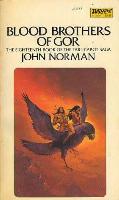
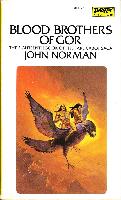

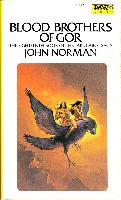


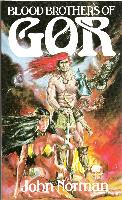
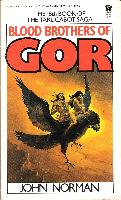



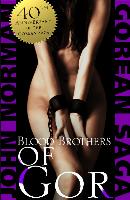
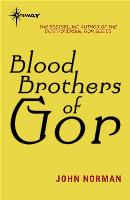

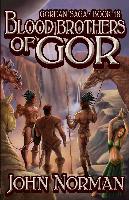

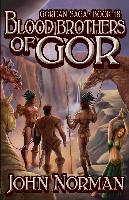
 Cover Gallery (edition)
Cover Gallery (edition)Here is a cover gallery showing all the editions and printings of Blood Brothers of Gor, sorted by edition. Click on any cover to see the book.


















 This page is copyright © 2000/2013 by Simon van Meygaarden & Jon Ard - All Rights Reserved
This page is copyright © 2000/2013 by Simon van Meygaarden & Jon Ard - All Rights Reserved